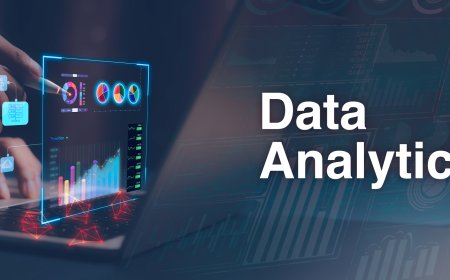The Role of Data Analytics in Ecosystem Conservation
Explore the transformative impact of data analytics on ecosystem conservation. Learn how cutting-edge technology informs real-time monitoring, predictive modeling, and targeted interventions for sustainable management.

In an era marked by unprecedented technological advancements, the integration of data analytics has emerged as a powerful tool in addressing complex challenges. One such critical arena where data analytics is proving to be a game-changer is ecosystem conservation. As our planet grapples with environmental threats and biodiversity loss, harnessing the power of data is essential for informed decision-making and sustainable management of ecosystems.
Understanding Ecosystem Dynamics
Understanding ecosystem dynamics is a fundamental aspect of effective ecosystem conservation. Ecosystems are intricate and dynamic systems where various living organisms interact with each other and their physical environment. The dynamics of these systems are shaped by complex relationships, feedback loops, and the continuous exchange of energy and nutrients. Conservationists and scientists seek to unravel the intricacies of these dynamics to formulate informed strategies for preservation and sustainable management.
Ecosystem dynamics encompass a wide range of factors, including the distribution and abundance of species, nutrient cycling, and responses to environmental changes. Traditional methods of studying ecosystems often involve on-the-ground field surveys, which provide valuable data but are limited in scale and scope. With the integration of data analytics, researchers can harness the power of technology to collect, process, and analyze vast amounts of data from various sources.
One crucial aspect of understanding ecosystem dynamics is the ability to monitor changes over time. This involves tracking alterations in climate patterns, habitat structures, and species compositions. Data analytics facilitates real-time monitoring through the utilization of satellite imagery, sensor networks, and other advanced technologies. This continuous flow of information allows scientists to observe trends, identify anomalies, and predict potential shifts in the ecosystem, providing a proactive approach to conservation.
Furthermore, studying ecosystem dynamics involves recognizing the impact of external factors such as climate change, human activities, and natural disasters. By employing data analytics, researchers can build predictive models that simulate how these external forces may influence ecosystems. This foresight is essential for developing strategies to mitigate negative impacts and enhance the resilience of ecosystems in the face of changing conditions.
Data Collection and Monitoring
Data Collection and Monitoring is a crucial aspect of ecosystem conservation, which involves the systematic gathering and analysis of information to understand, manage, and protect natural environments. This process is essential for making informed decisions, tracking changes, and implementing conservation strategies effectively. Here are some key elements and explanations regarding data collection and monitoring in the context of ecosystem conservation:
Data Sources: Data collection involves obtaining information from various sources. These sources can include field surveys, satellite imagery, sensor networks, remote sensing technology, historical records, and citizen science initiatives. The diversity of data sources allows conservationists to create a comprehensive and multi-dimensional view of ecosystems.
Real-time Monitoring: Real-time monitoring is essential to data collection in modern ecosystem conservation. Sensor networks, satellite technology, and other automated systems provide continuous data streams. This real-time data is crucial for quickly identifying and responding to threats such as wildfires, habitat disturbances, or illegal activities.
Spatial and Temporal Data: Ecosystems change over both space and time. Data collection in ecosystem conservation encompasses spatial data, which involves mapping and monitoring specific geographic areas, as well as temporal data, which tracks changes and trends over time. This enables conservationists to understand the dynamics and evolution of ecosystems.
Biodiversity Monitoring: Data collection and monitoring are instrumental in tracking biodiversity. This includes the documentation of various species, their populations, distribution, and changes in abundance over time. Conservationists use this data to assess the health and diversity of ecosystems and to identify species at risk.
Habitat Assessment: Data collection methods also focus on evaluating the quality and extent of different habitats within ecosystems. This information helps conservationists target specific areas for protection, restoration, or habitat management, to preserve biodiversity and ecosystem health.
Climate and Environmental Data: Understanding the impacts of climate change and environmental variables is critical. Collecting data related to temperature, precipitation, sea level, and other environmental factors enables conservationists to assess the influence of climate change on ecosystems and develop strategies to mitigate its effects.
Predictive Analytics for Climate Change
Predictive analytics for climate change represents a cutting-edge approach to addressing the escalating challenges posed by global environmental shifts. In essence, it involves the use of advanced statistical algorithms and machine learning models to analyze vast datasets related to climate variables. These datasets encompass historical weather patterns, atmospheric conditions, and oceanic trends, among other crucial factors. The overarching goal is to develop predictive models to anticipate future climate scenarios, providing valuable insights into the potential impacts on ecosystems, biodiversity, and human societies.
These predictive models are not crystal balls but sophisticated tools that assimilate complex interactions within Earth's climate systems. They consider variables such as greenhouse gas emissions, temperature changes, and sea level rise, aiming to project how these factors might evolve. Predictive analytics in climate change is invaluable for policymakers, scientists, and conservationists alike, offering a glimpse into possible future scenarios. This foresight is crucial for devising adaptive strategies that can mitigate the adverse effects of climate change and enhance the resilience of ecosystems.
One significant application of predictive analytics for climate change is understanding shifts in habitat distribution and species migration patterns. As temperatures rise and climate zones change, certain species may need to adapt or migrate to survive. Predictive models help scientists identify potential areas where these changes might occur, enabling proactive conservation efforts. Additionally, these models aid in assessing the vulnerability of different regions to climate-related events, such as extreme weather events or changes in precipitation patterns.
Wildlife Conservation
Wildlife conservation is a multifaceted endeavor aimed at safeguarding Earth's diverse and often threatened animal species and their natural habitats. It is a vital component of broader conservation efforts focused on maintaining ecological balance, protecting endangered species, and ensuring the sustainability of our planet's ecosystems. Here, we'll explore the concept and importance of wildlife conservation.
Biodiversity Preservation
Biodiversity refers to the variety of life on Earth, encompassing the rich tapestry of species that inhabit our planet. Wildlife conservation seeks to preserve this diversity by protecting various species from extinction. Biodiversity is essential for ecosystem stability and resilience, as different species play unique roles in maintaining ecological balance.
Endangered Species Protection
One of the primary objectives of wildlife conservation is the protection of endangered and threatened species. These species are at risk of disappearing from the planet, often due to human activities like habitat destruction, poaching, pollution, and climate change. Conservation efforts focus on monitoring, breeding, and reintroducing these species into their natural habitats.
Habitat Restoration and Preservation
Preserving and restoring natural habitats is a fundamental aspect of wildlife conservation. Healthy ecosystems provide shelter, food, and breeding grounds for a wide range of species. By conserving these habitats, we indirectly safeguard the wildlife that relies on them.
Sustainable Resource Management
Wildlife conservation promotes the responsible and sustainable management of natural resources. This includes regulating hunting, fishing, and timber harvesting to ensure that these activities do not threaten the survival of species or ecosystems. Sustainable resource management aims to balance human needs with ecological health.
Ecosystem Restoration
Ecosystem restoration is a deliberate and strategic effort to rehabilitate degraded or damaged ecosystems, aiming to bring them back to a state of ecological health and resilience. This multifaceted approach involves the rehabilitation of habitats, the reintroduction of native species, and the mitigation of factors contributing to ecosystem decline. The goal is not only to repair the physical structures of ecosystems but also to reinstate their natural processes and functions.
Ecosystem restoration recognizes the interconnectedness of all living organisms and their environment, emphasizing the importance of biodiversity in sustaining healthy ecosystems. Whether it's reforesting deforested areas, restoring wetlands, or revitalizing coral reefs, ecosystem restoration is a crucial tool in the broader conservation toolkit, contributing to global efforts to combat biodiversity loss and address the impacts of climate change.
Challenges and Ethical Considerations
The integration of data analytics in ecosystem conservation, while promising, comes with a set of challenges and ethical considerations. One major concern involves data privacy, as the collection and analysis of vast amounts of environmental data may inadvertently expose sensitive information. Striking a balance between data-driven insights and safeguarding individual privacy is crucial. Additionally, the algorithms used in data analytics can carry biases, potentially influencing conservation decisions and resource allocation.
Ensuring fairness and transparency in these algorithms is essential to prevent unintended consequences. Furthermore, questions about the equitable distribution of benefits and burdens associated with data analytics in conservation must be addressed, as marginalized communities may bear disproportionate impacts. Navigating these challenges requires a careful examination of ethical frameworks to guide the responsible use of data in the pursuit of sustainable ecosystem conservation.
The role of data analytics in ecosystem conservation is transformative, offering unprecedented insights and opportunities for sustainable management. As we navigate the complexities of environmental challenges, leveraging the power of data is not just an option but a necessity. By embracing technological advancements responsibly, we can pave the way for a future where ecosystems thrive, biodiversity flourishes, and our planet sustains life for generations to come.











































